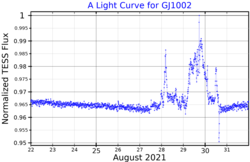Astronomy:GJ 1002
From HandWiki
(Redirected from Astronomy:GJ 1002 c)
Short description: Red dwarf star in the constellation Cetus
| Observation data Equinox J2000.0]] (ICRS) | |
|---|---|
| Constellation | Cetus[2] |
| Right ascension | 00h 06m 43.19732s[3] |
| Declination | −07° 32′ 17.0191″[3] |
| Apparent magnitude (V) | 13.837±0.003[4] |
| Characteristics | |
| Evolutionary stage | Main sequence |
| Spectral type | M5.5V[4] |
| Apparent magnitude (V) | 13.837±0.003[4] |
| Apparent magnitude (G) | 11.774±0.003[3] |
| Apparent magnitude (J) | 8.323±0.019[4] |
| Apparent magnitude (H) | 7.792±0.034[5] |
| Apparent magnitude (K) | 7.439±0.021[5] |
| Astrometry | |
| Radial velocity (Rv) | −40.46±0.30[3] km/s |
| Proper motion (μ) | RA: −811.566[3] mas/yr Dec.: −1893.251[3] mas/yr |
| Parallax (π) | 206.3500 ± 0.0474[3] mas |
| Distance | 15.806 ± 0.004 ly (4.846 ± 0.001 pc) |
| Details[4] | |
| Mass | 0.120±0.010 M☉ |
| Radius | 0.137±0.005 R☉ |
| Luminosity (bolometric) | 0.001406±0.000019 L☉ |
| Surface gravity (log g) | 5.10±0.06 cgs |
| Temperature | 3024±52 K |
| Metallicity [Fe/H] | −0.25±0.19 dex |
| Rotation | 126±15 d |
| Other designations | |
| Database references | |
| SIMBAD | data |
GJ 1002 (or Gliese 1002) is a nearby red dwarf star, located 15.8 light-years (4.8 parsecs) away from the Solar System in the constellation of Cetus. The star has 12% the mass and 14% the radius of the Sun, and a temperature of 3,024 K (2,751 °C; 4,984 °F). It hosts a system of two known exoplanets.[4]
Planetary system
Two planetary companions to GJ 1002 were discovered in 2022 via radial velocity. Both have minimum masses close to that of Earth and orbit within the habitable zone of their star. While these planets do not transit their host star, it may be possible to determine the presence and composition of atmospheres with future instruments such as the ANDES spectrograph for the Extremely Large Telescope.[4]
| Companion (in order from star) |
Mass | Semimajor axis (AU) |
Orbital period (days) |
Eccentricity | Inclination | Radius |
|---|---|---|---|---|---|---|
| b | ≥1.08±0.13 M⊕ | 0.0457±0.0013 | 10.3465±0.027 | — | — | — |
| c | ≥1.36±0.17 M⊕ | 0.0738±0.0021 | 21.202±0.013 | — | — | — |
See also
References
- ↑ "MAST: Barbara A. Mikulski Archive for Space Telescopes". Space Telescope Science Institute. https://mast.stsci.edu/portal/Mashup/Clients/Mast/Portal.html.
- ↑ "Finding the constellation which contains given sky coordinates". 2 August 2008. http://djm.cc/constellation.html.
- ↑ 3.0 3.1 3.2 3.3 3.4 3.5 Vallenari, A. et al. (2022). "Gaia Data Release 3. Summary of the content and survey properties". Astronomy & Astrophysics. doi:10.1051/0004-6361/202243940 Gaia DR3 record for this source at VizieR.
- ↑ 4.0 4.1 4.2 4.3 4.4 4.5 4.6 4.7 Suárez Mascareño, A. et al. (December 2022). "Two temperate Earth-mass planets orbiting the nearby star GJ 1002". Astronomy & Astrophysics 670: A5. doi:10.1051/0004-6361/202244991. Bibcode: 2023A&A...670A...5S.
- ↑ 5.0 5.1 5.2 "GJ 1002". SIMBAD. Centre de données astronomiques de Strasbourg. http://simbad.u-strasbg.fr/simbad/sim-basic?Ident=GJ+1002.
 |


